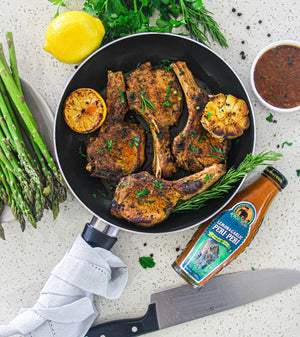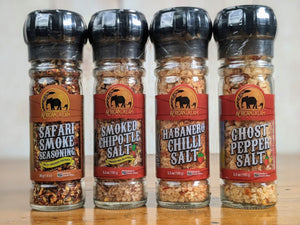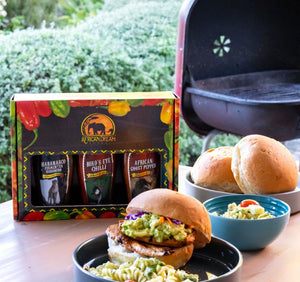How to Find Your Perfect Hot Sauce Heat Level
Aug 12, 2025
For hot sauce lovers, the thrill of spice is part of the journey. But let’s be honest—how many times have you picked up a bottle of sauce, read the label, and wondered: what do these numbers actually mean? You’ll often see references to the Scoville scale, pepper heat ratings, or even a branded 1–10 hot sauce scale—but it’s not always clear how they connect.
This guide dives deep into hot sauce Scoville scale measurements, the science behind understanding spice levels, and how to use hot sauce ratings (like our 1–10 system) to find your perfect match. Whether you’re a casual hot sauce dabbler or a certified chili-head, understanding the numbers will help you choose wisely—and enjoy your meals without any fiery regrets.
What Is the Scoville Scale?

The Scoville scale is the universal measurement for chili pepper heat. Invented in 1912 by Wilbur Scoville, it measures the pungency—or “spicy heat”—of peppers in Scoville Heat Units (SHU).
-
Mild peppers, like bell peppers, rank at 0 SHU.
-
Medium peppers, like jalapeños, range between 2,500–8,000 SHU.
-
Super-hot peppers, like ghost peppers and Carolina Reapers, can skyrocket past 1,000,000 SHU.
The scale works by identifying the concentration of capsaicin, the compound that causes the burning sensation. The higher the SHU, the more capsaicin—and the more intense the heat.
But here’s the catch: not everyone experiences capsaicin the same way. Some people feel heat more intensely, while others build tolerance over time. That’s why understanding both Scoville ratings and simplified hot sauce scales helps balance expectations.
Why Hot Sauce Heat Levels Can Be Confusing
If the Scoville scale exists, why do hot sauce brands create their own 1–10 heat scales?
The answer: Scoville units don’t always tell the whole story.
A sauce’s heat level isn’t just about the pepper it’s made from. Other factors play a big role:
-
Pepper concentration – A sauce might include ghost peppers, but if it’s diluted with fruit or vinegar, the heat will be milder.
-
Cooking methods – Fermented sauces can taste spicier because of intensified flavors.
-
Additional ingredients – Sugar, garlic, or creaminess can balance out the burn.
-
Personal perception – Someone new to spice may find a jalapeño sauce fiery, while a seasoned chili lover calls it “mild.”
That’s why a 1–10 hot sauce rating system makes spice levels more approachable. It translates complex Scoville measurements into something everyone can understand.
Breaking Down Our Hot Sauce Rating Scale (1–10)
At African Dream Foods, we use a 1–10 heat rating system to guide customers. This doesn’t replace the Scoville scale—it complements it, turning SHUs into a practical, taste-tested number.
Here’s how the scale works:
-
1–2: Gentle Warmth
Barely-there spice. Think mild BBQ sauces or chili ketchup. Perfect for beginners. -
3–4: Mild Heat
Sauces with jalapeños or Lemon & Garlic Peri-Peri fall here. Noticeable heat, but very approachable. -
5–6: Medium Heat
Sauces like Ghost Peri-Peri bring a balanced kick. They’re ideal for people who enjoy a little sweat while eating. -
7–8: Hot
Habanero-based sauces sit here. Expect lingering heat that elevates dishes but doesn’t overpower flavor. -
9: Very Hot
For chili lovers only. A sauce with ghost peppers starts pushing the limits. -
10: Extreme Heat
Pure fire. Super-hot peppers dominate here—sauces you’ll want to use sparingly.
This scale bridges the gap between scientific Scoville ratings and real-world flavor experiences.
Scoville Scale vs. Hot Sauce Ratings
Let’s map out how Scoville Heat Units compare with a 1–10 rating system:
| Heat Rating | Scoville Range | Pepper Examples | Experience |
|---|---|---|---|
| 0 | 0 SHU | Bell pepper | No heat |
| 1–2 | 100–2,500 SHU | Banana pepper, pimento | Barely spicy |
| 3–4 | 2,500–10,000 SHU | Jalapeño | Gentle warmth |
| 5–6 | 10,000–50,000 SHU | Serrano, cayenne | Noticeable kick |
| 7–8 | 50,000–350,000 SHU | Habanero | Hot, lingering burn |
| 9 | 350,000–800,000 SHU | Ghost pepper | Serious fire |
| 10 | 1,000,000+ SHU | Carolina Reaper | Extreme, for pros only |
This table shows why a simplified heat scale is more useful in practice—you don’t have to memorize SHU numbers; you just need to know where your comfort zone lies.
How to Find Your Perfect Hot Sauce Heat Level

Choosing a hot sauce should feel exciting, not intimidating. Here are tips to match your taste buds with the right rating:
1. Identify Your Tolerance
-
Beginner: Start with mild (1–4). Focus on flavor-forward sauces with just a touch of heat.
-
Intermediate: Try medium (5–6). Enough spice to excite without overwhelming.
-
Chili Lover: Go for hot (7–8). These deliver real punch while staying enjoyable.
-
Heat Seeker: Explore extreme (9–10). Best used sparingly or in adventurous recipes.
2. Match Heat Levels to Meals
-
Mild sauces (1–4) shine on eggs, roasted veggies, or light proteins like chicken.
-
Medium sauces (5–6) complement grilled meats, tacos, and rice dishes.
-
Hot sauces (7–8) work beautifully in marinades, stir-fries, or spicy pasta.
-
Extreme sauces (9–10) are for bold dips, chili challenges, or adding drops to big batches of stew.
3. Use the Scoville Scale as a Reference
If you see “250,000 SHU” on a label, compare it to the 1–10 guide. In this case, it’s about a 7–8 rating—habanero-level heat.
Understanding Spice Levels Beyond the Numbers
Numbers help, but they don’t tell the whole story. When it comes to hot sauce, flavor matters as much as heat.
Flavor Profiles That Influence Perception
-
Smoky: Chipotle-based sauces can feel richer, making spice taste deeper.
-
Fruity: Mango or pineapple balances fiery peppers with sweetness.
-
Tangy: Vinegar-heavy sauces feel sharp and zesty, often amplifying perceived heat.
-
Earthy: Fermented sauces add depth and complexity.
Two sauces with the same Scoville rating can taste very different depending on these flavor layers.
The Psychology of Heat
Why do we keep chasing spicier sauces, even when they make us sweat? Science has an answer:
-
Capsaicin triggers endorphins. Your body releases feel-good chemicals to counteract the “pain.”
-
It’s a thrill. Just like riding a rollercoaster, spicy foods deliver a safe adrenaline rush.
-
Heat tolerance grows. The more spice you eat, the more your body adapts.
This explains why someone might start with a jalapeño sauce and eventually crave ghost pepper heat.
Hot Sauce Ratings in Action
Let’s look at how different sauces line up on the scale:
-
Southern Braai (1/10) – Mild and BBQ-inspired, great for everyday use.
-
Lemon & Garlic Peri-Peri (4/10) – Zesty with a gentle chili kick.
-
Ghost Peri-Peri (6/10) – A balanced medium heat that’s versatile.
-
Habanasco – Fermented Habanero (8/10) – Complex, hot, and lingering.
-
African Ghost Pepper (10+/10) – Not for the faint-hearted—an extreme sauce for chili warriors.
These examples show how you can move up (or down) the ladder depending on your taste preferences.
How to Experiment With Hot Sauce Heat Safely
If you’re testing new spice levels, do it gradually:
-
Start small. Add a drop or two to your meal.
-
Mix with food. Combine hot sauce with mayo, yogurt, or honey to mellow heat.
-
Have cooling sides. Keep bread, rice, or dairy handy to balance the burn.
-
Take notes. Pay attention to which heat levels feel exciting vs. overwhelming.
This way, you’ll learn your “sweet spot” on the scale.
The Cultural Side of Spice
Heat levels also depend on cultural cuisine. What’s considered “mild” in Mexico or Thailand may feel intense in the U.S. or Europe. Hot sauce scales help bridge these cultural differences, making global flavors more approachable.
Conclusion: Making Sense of the Heat
Understanding the Scoville scale, spice levels, and hot sauce ratings transforms the way you shop and cook. Instead of guessing, you can confidently pick a sauce that matches your heat tolerance and enhances your food.
Remember:
-
The Scoville scale measures capsaicin in peppers.
-
A 1–10 rating system translates those numbers into real-world experience.
-
Flavor profiles, tolerance, and culture all shape how we feel spice.
So, the next time you see a bottle labeled “6/10,” you’ll know exactly what to expect: a medium, balanced burn that excites your taste buds without overwhelming them.
Hot sauce isn’t just about heat—it’s about flavor, culture, and the adventure of pushing your palate just a little further each time.



